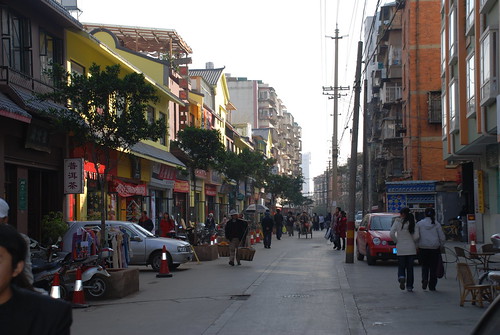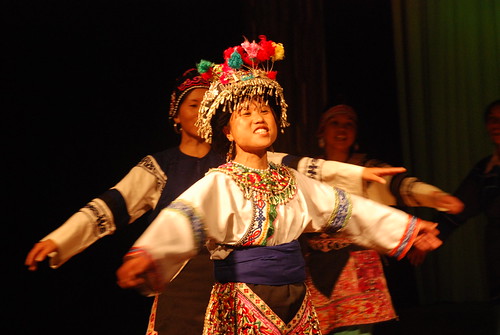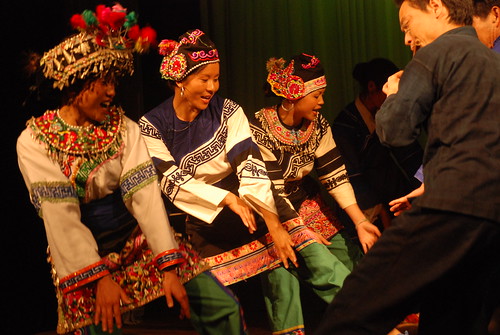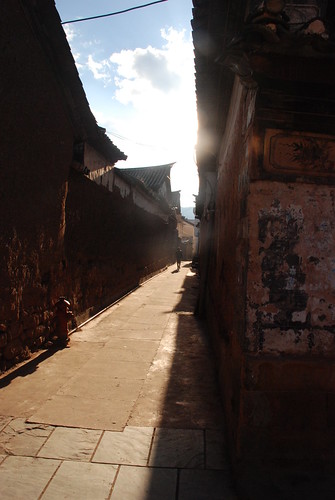
I’ve ranted and raved a lot about Kunming before, so there’s no need to introduce the place again. We came on a mission, but we were basically there to soak up some of what the city had to offer. Between marathon meals and walks in the park, we actually managed to get some work done. For the first day, I called on my old friend Xie Mohua who is the director of the Yunnan Minority Nationalities Museum, which in my opinion is one of the most overlooked gems in the city. He gave me big face by offering us free access to the museum with his top researchers acting as guides, then free use of his lecture hall. He also brought out some of Yunnan’s top historians to tell us what they know about ancient Yunnan and the caravans.
The museum is right down by Lake Dian on the southwest edge of the city, across the street from the zoo-like Yunnan Nationalities Village theme park. Though most tourists only bother to visit the theme park for a dose of cultural misconceptions, the museum is almost always empty. It has an amazing collection of Yunnan clothing and textiles, as well as just about any artifact you can imagine including religious implements, musical instruments, ritual masks, hemp looms and weaponry.
One of my favorite exhibits there is called “Memories of Mankind”, which is a complete collection of every form of written language and communication system found among the peoples of Yunnan Province. There are stacks of Tibetan sutras, Yi scriptures and Thai palm-leaf sutras. There are old texts in the Dongba script from the Naxi of Lijiang, which is the only pictographic script still in use today. One can also see the Daoist paintings of the Yao people, who adopted Daoism and the Chinese writing system, though they changed it around along the way making the Chinese characters something akin to the work of an American tattoo artist. One of the most interesting sections of the exhibit is reserved for communication by illiterate peoples. In one culture, sending palm leaves woven in a certain way tells the recipient “I like you a lot, but I’m in a relationship right now. Sucks to be you.” A chili pepper sent to a relative says “it is time to exact our revenge”.
Every time I go to the museum, I end up spending most of my time (and money) in either the bookshop or the clothing shop. The book shop is entirely dedicated to books on China’s minority cultures, and any Chinese book on the topic worth its salt can be found or ordered there. The clothing shop downstairs is a well kept secret among textile nuts that I am revealing for the benefit of my handful of dedicated readers. The shop is run by the museum’s former appraiser, who basically oversaw the purchase of the museum’s entire collection. Ms. Wu now uses her extensive contacts in the countryside and her keen collector’s eye to track down the best traditional clothing, embroidery, jewelry and knickknacks to be had in Yunnan. The shop is overflowing with the stuff, but I haven’t come across a single item that she couldn’t pinpoint to its exact village and ethnic origin. Ms. Wu claims that 90% of her business is in long term repeat buyers, and I believe her.
Unfortunately I didn’t get to spend a whole lot of time blowing my wallet that day, because the lecturers were on a tight schedule. Our first lecture of the day was by Mu Jihong, something of a legend among puer tea fanatics. Some time in the nineties, he and a few colleagues heard chatter about a possible southern passage on the Silk Road. Somehow, artifacts from Yunnan and Sichuan were turning up in places like Kazakhstan, and it just didn’t make sense for this stuff to travel all the way up to Xian to cross the desert or all the way across India to end up in Central Asia. Mr. Mu and five others got together to tackle the problem, and soon honed in on the old Tibetan traders that used to send caravan teams into Yunnan for tea and salt. They made a small caravan team of their own to retrace the path and find out everything they could. They found that the caravan trading routes were much more extensive than previously believed, stretching across Yunnan, Sichuan and Tibet, and reaching into India and Central Asia. The trade dates back at least 4000 years. In later ancient times, Yunnan and Tibetan merchants amassed large fortunes trading tea and salt (two scarce necessities on the Tibetan Plateau) for prized Tibetan horses, which they sold to the Chinese Empire, which was always under attack from northern nomads.
The six men returned and named the trading route the “Ancient Tea and Horse Road”, as they saw plenty of tea and horses, but not a lot of silk. Mu Jihong gave us a wonderful account of his travels, and explained the economics and history of the trading route to us.
Our next speaker is an old friend of mine, Guan Yuda. He teaches art at Yunnan University, and gave our people a background on Yunnanese art and culture, as well as a colorful explanation of why the place has always been a vortex for all kinds of whackos. A lot of people don’t realize this, but Yunnan is one of the most important places in China for modern and contemporary art, and also served as an important conduit for the exchange of artistic ideas across Asia in ancient times (more on that in the Dali section). One of the first modern art movements to make waves abroad was the Yunnan school in the early eighties, with its flashy and seductive oil color renderings of Yunnan’s tropical borderlands. That was just a blip on the map, but China’s contemporary art scene has exploded on the world stage, and no other province, region or city has produced more tier one artists than Yunnan. We’re talking Mao Xuhui, Ye Yongqing, Tang Zhigang and Pan Dehai, not to mention Zhang Xiaogang who is currently number one in terms of sales prices and cultural influence. Guan’s explanation is that Yunnan has always been exposed to and receptive of outside influences. It has always been an amazingly diverse (and poorly controlled) frontier region as well as a dumping ground for bad elements and banished officials from Beijing. Yunnan’s modern culture dates back to the ‘30’s when China’s entire top-tier education system sought refuge there from the Japanese, establishing the Southwestern United University, flooding the city with China’s most forward-thinking intellectuals. They bumped shoulders with the French, who still hoped to make it part of Indochina, and the Americans who came as the volunteer fighting outfit soon to be dubbed the Flying Tigers. Yunnan today still beckons to lost souls from all generations who wander there for various personal reasons and end up smoking dope, dancing barefoot and bringing home the seeds of China’s new bohemian culture.
Our last speaker was Li Kunsheng, incidentally also a professor at Yunnan U. He teaches in the history department, and is one of the most important minds in Yunnan archaeology and ancient cultures. He gave us a rundown of the political and cultural situation of Yunnan during the Nanzhao and Dali kingdoms, a period of several centuries that coincided with the Tang and Yuan dynasties in the rest of China. The Nanzhao Kingdom is believed to have been a kingdom of the Yi people centered in Dali. It traded with Tibet, China and India, and at its height controlled a territory stretching across the province and all the way to the Indian Ocean. It held its own against the peak of ancient Chinese civilization (the Tang) and once even defeated an army of 100,000 soldiers. One of its greatest cultural treasures is the series of stone carvings in the mountains of Shibaoshan, which I will return to in the Dali chapter.

Our last major happening in Kunming was a dose of traditional folk culture as it lives and breathes. I took my posse to check out another posse of mine, the Yuansheng dance group. This is a folk-based group consisting of a lot of the traditional dancers we brought to the states in 2005 (see Yunnan Revealed ). They’ve built a theatre in Kunming’s Loft Art Community and have been holding regular performances there for the past year. It was great to see my old friends. They’re living well, spreading the word of cultural preservation, and gaining support in their continuing community work. The hypnotic music brought me back to one of the best moments in my life, stirring up some of the happiest and saddest memories of my days in Kunming. It was the first time for my posse, and they were absolutely blown away. I’m glad that they got to learn a bit about Yunnan from bona-fide peasants, because they represent Yunnan and what it’s about much more than any group of the most accomplished scholars.

The rest of my weekend was about preparing for the trip and going out for drinks with a lot of old friends you’ve never heard of. I won’t bore you with the details. Next installment, the trading town of Weishan and the mighty kingdom of Dali…



